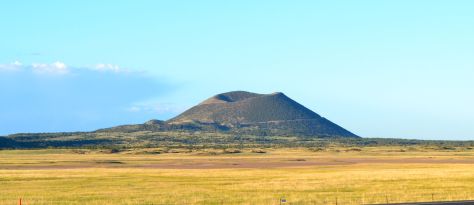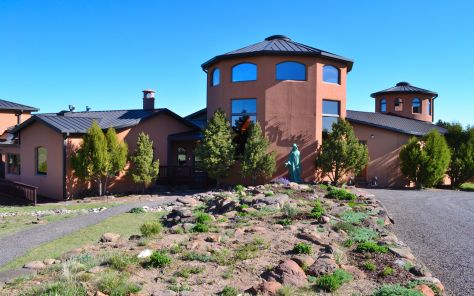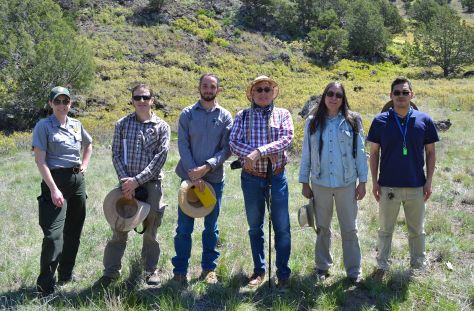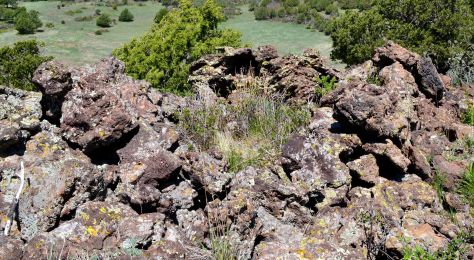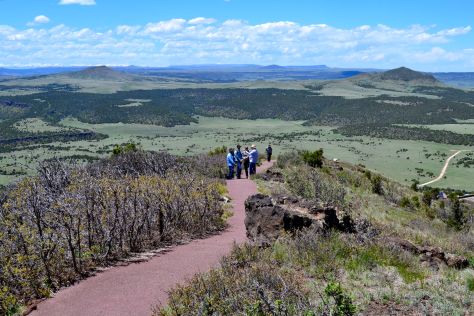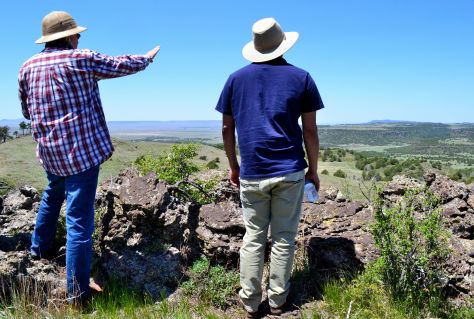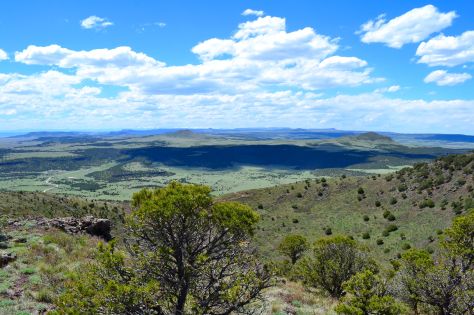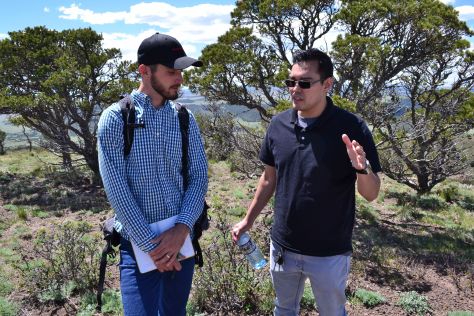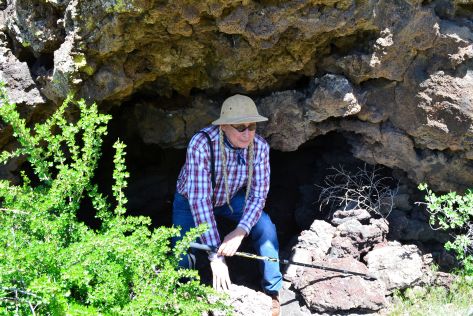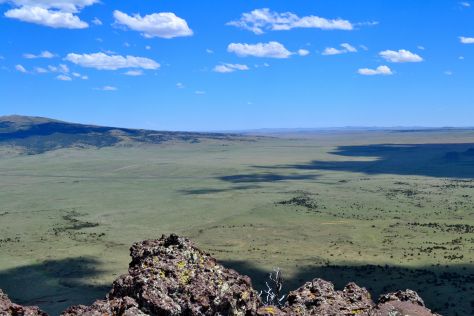Pawnee Creek weaves a slender thread of water across a hot summerland. In this corner of the arid Colorado High Plains, the world paused one day, and history uttered a tale of curious intersections and collisions. A tale of human diversity. A tale of segregated humankind. And in Pawnee tradition… once upon a time Spider Woman helped the Skidi here; then she spread her legs on a hillside and she made Pawnee Creek.
In mid-September 2018 my wife and I traced on maps the route of Pawnee Creek across northeastern Colorado, and we set forth to visit the stream. The final stretch of this waterway long ago gave way to modernity. Where it adjourns into the Flat River, it becomes a modest irrigation ditch. Just beyond a No Trespassing sign we found a herd of cattle browsing on a field of almost bare dirt.
Noticing a sidelong track, we soon discovered a hidden parking area – and Dune Ridge State Wildlife Area. Hiking across a field to the shore of the Flat River, we stood among butterflies. Migrant Monarchs daydreaming in the shade. Peering down the stream I could see a scatter of trees where Pawnee Creek irrigates the shallows of the Flat River.

The Flat River at the mouth of Pawnee Creek
One summer day almost two hundred years ago some American travelers paused in Pawneeland on the Many Wild Potatoes River. At Kítkhahaahpakuhtu’, the Skidi metropolis, it was June 1820. There the Long expedition enlisted several French-American guides – one was Joseph Bijeau, an American trader with French-Canadian ancestry, hired to serve as “guide and interpreter.” He was fluent in French and English and Pawnee, and he “was partially acquainted with several Indian languages; in particular, that of the Crow nation, which is extensively understood by the western tribes…”
It is apparent that Bijeau had a son with a Skidi woman. One Long expedition chronicler described the wives of the French-American traders in that city as wearing “moccasins, legings of red serge” and “Shoud [stroud] of blue cloth, a kind of short petticoat ornamented around the bottom with red or yellow binding – and a shirt of callico fringed round the neck & bosome of the same material.” In those days calico became popular among the women in Pawneeland. My great-grandfather’s grandmother was born in a Kitkahahki city sometime around 1800 and she became known as Cihiitu, Calico Woman.
On June 14 the Americans departed from Kítkhahaahpakuhtu’. Over the next few days they stopped at various Pawnee campgrounds, then they arrived at a locale where they noticed two human skulls on the ground. Edwin James said that the French-American guides didn’t know what had happened there. But Captain John Bell heard that “Chayennes” had accosted a “Pawnee party” here and they had killed everyone except one survivor. Thomas Say selected a skull and packed it up and the Americans carried it back to the United States.
On June 28 the Long expedition journeyed along the south side of the Flat River in the west of Pawneeland and they saw herds of wild horses, several rattlesnakes, a fox, a buffalo, a curious antelope – and that day they passed a stream “called by the Indians Bat-so-ah, or Cherry creek…” The term is not Pawnee or French. It is probably a Crow term, báachuua, meaning chokecherry. We can guess that the name was supplied by Joseph Bijeau who was “partially acquainted” with Crow. This moment arose at the edge of Pawneeland from a complicated cultural quilt. An American expedition. A French-American with French-Canadian ancestry. A Skidi family. Rumor of the wandering Crows.

A view of Long’s Peak from Longmont, Colorado
Several days later this party saw far mountains “upon the luminous margin of the sky” and the Americans decided they were seeing “the point designated by Pike as the Highest Peak.” Pike’s Peak. But no. This was a mountain farther north. In time that mountain became known as Long’s Peak, named after Stephen Long, the leader of the American party. The Americans continued on to Pike’s Peak. And they journeyed onward through the Great Plains.
After they returned to the United States, the Pawnee skull picked up by Thomas Say made its way into the hands of Samuel Morton. Morton studied the skull, and he wrote about it in his 1839 book, Crania Americana. Generalizing about “The American Race” Morton came to the scientific conclusion that his collection of kidnapped skulls revealed an aversion “to cultivation” and a people “slow in acquiring knowledge; restless, revengeful, and fond of war, and wholly destitute of maritime adventure.”
In those days a ferment of racial ideas had already given rise to the primary formal tenets of racial Indianhood – ideas invented in the academic ponderings of American and European philosophers and widely adopted and embraced among adherents to the new identity system. The American imagination had by then drawn on experiences with a Skidi named Pitarisaru (Man Chief) to formulate the stereotype of the noble Plains Indian warrior. Race would define the Pawnee-American relationship. Racial Indianhood would flow from those days into the future.
An artist named John Collins made a lithograph of the Pawnee skull for Morton, and according to historian James Poskett, Morton sent a copy of the lithograph to a colleague in England. This lithograph caused a stir at the next annual meeting of the British Association for the Advancement of Science. One phrenologist peered at it and decided the forehead of the Pawnee was “villainously low.”

John Collins lithograph, “Pawnee”
And BAAS sponsored a special committee that drew up a new protocol for ethnology. A protocol that added momentum to the idea “that many races now existing are likely, at no distant period, to be annihilated.” This committee devised guidelines for British travelers, encouraging the production of ethnographic notes on 89 topics. The racial stereotype of the vanishing Red Indian became firmly rooted in European intellectual culture; this ethnohistory became a matter of weaker races inevitably giving way to stronger racial types.
I don’t know when Cherry Creek became Pawnee Creek. It appears as Pawnee Creek on one 1866 map of Colorado and again on an 1880 map. The waterway winds down from Pawnee Buttes. One 1902 account gave an interesting history, saying it became known as Pawnee Creek “because a party of 200 Pawnee Indians were here surrounded by a greatly outnumbering force of Sioux, who, when they found they could not capture the Pawnees, proceeded to starve them out; but the Pawnees refused to surrender to escape even this death, and the last man of them perished by starvation.”
This must refer to a narrative that became embedded in Pawnee storytelling as a useful interpretive lens: the story of Pawnee Rock – a tale that overflowed onto the summits of Courthouse Rock and Pawnee Buttes. We can guess that a variety of incidents may have fed into the making of this tale, but it could also have arisen from a single incident. In the Pawnee Buttes story, after the battle, Spider Woman made a spring that flowed from the hillside – Pawnee Creek.

Historian David Bernstein published a 2018 book that touched briefly on this matter. A Skidi woman named Mary Faw Faw testified during the 1950s that some Pawnees got trapped on Pawnee Rock by “several tribes” and there was a battle and four Pawnees survived. One survivor was her grandfather. Mary Ricketts Faw Faw was the daughter of Charlie Walker (born circa 1837-1841), and he was the son of Te-ha-ka-ha-lus-pe – this could have been the grandfather who took part in the events at Pawnee Rock. And we can surmise that those events happened sometime before 1831. Te-ha-ka-ha-lus-pe dwelt at Kítkhahaahpakuhtu’ when the Long expedition appeared there in 1820; he knew Joseph Bijeau; he may have even known the Pawnee whose skull ended up a topic of interest in Britain.
Ancestors of the Pawnees once resided along the western edge of Pawneeland. People today associate this region with later immigrants who briefly touched down here, like the Arapaho and Cheyenne. But the ancient forgotten residents of this realm long ago helped give rise to the Kawarakis Pawnees and the Skidi.
During the early 19th century this region served as a crossroads. People met here, they traded, they hunted together, they raided each other, they intermarried, they killed one another, and they picked up skulls and they wondered what it means to be human. In this story we glimpse Americans, Canadians, the French, the Pawnees, the Crows, the Cheyennes, the Sioux, and the British. Wandering at the feet of Those Distant Rocks, they manufactured the manifold details of the various stories they would pass down into the future. The truths of human diversity give this story a particular kind of depth. But in those days “diversity” had to be properly managed; everyone tumbled into the rigid channels of racial thinking and the pathologizing of diversity.
And one day in mid-September 2018 I stood on the shore of the Flat River among butterflies. Pausing beside Pawnee Creek for a moment, I watched the water flow on, as if to find its hidden destiny, mingling with the Flat River, mingling with the Mysterious River, mingling with the Dark River… whispering onward to the edge of the world.









